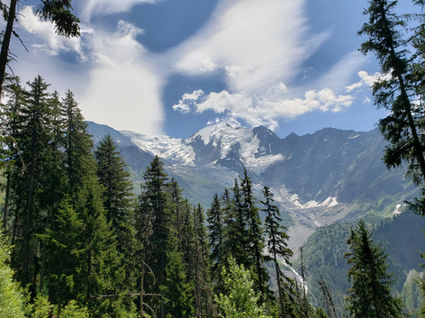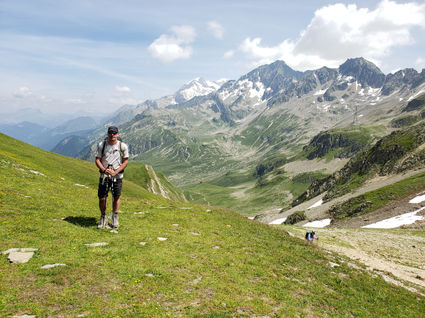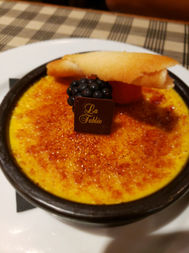Enlightened Adventures

Tour du Mont Blanc
The Tour du Mont Blanc (TMB) is a legendary hiking trail that circumnavigates Mont Blanc, the tallest mountain in Western Europe. Spanning approximately 170 kilometers (106 miles), this incredible trail takes you through parts of France, Italy, and Switzerland. Experience three distinct cultures and cuisines as you hike through one of the most scenic places on earth. The trail is challenging, but nothing you can't handle. TMB is a must if you happen to like Awesomeness.
History
The roots of the Tour du Mont Blanc (TMB) trail can be traced back to the 18th century, when the Mont Blanc massif captivated explorers and scientists alike. The first to circumnavigate the range was Horace-Bénédict de Saussure, a Swiss geologist, in 1767. His expedition, though not a leisurely hike, laid the groundwork for the TMB as we know it today.
In the 19th century, the TMB began to gain popularity as a trekking route. Wealthy travelers, particularly from England, would embark on the journey, often on muleback, to experience the grandeur of the Alps. The construction of mountain refuges and improved infrastructure further facilitated access to the region.
Over time, the TMB evolved into a challenging yet rewarding hiking trail. The route has been refined and maintained, offering stunning views, diverse landscapes, and a unique cultural experience. Today, it remains one of the most popular long-distance hiking trails in Europe, attracting thousands of hikers each year.

Photo hanging on my wall
Gallery
The Hike
The Tour du Mont Blanc (TMB) is one of the most iconic long-distance hiking trails in Europe. This challenging yet rewarding trek circles the Mont Blanc massif, offering breathtaking views of towering peaks, glaciers, alpine meadows, and charming villages.
Countries Traveled
The TMB traverses France, Italy and Switzerland each clarifying its distinction as you pass through. The trail allows a unique opportunity to experience the different cultures and cuisines of three countries all along one path. It truly adds to this already amazing trek.
Terrain and Challenges
The TMB offers a diverse range of terrain, from gentle valleys to steep ascents and descents. Hikers can expect to encounter:
-
Alpine meadows: Lush green pastures dotted with wildflowers
-
Mountain passes: High-altitude crossings with stunning panoramic views
-
Glacial valleys: Dramatic landscapes shaped by ancient ice
-
Rocky trails: Technical sections requiring careful footing
The physical demands of the TMB are significant. Hikers should be prepared for long days of walking, often on uneven terrain.
Length and Elevation Gain
The standard TMB route is approximately 170 kilometers (106 miles) long, with a total elevation gain of around 10,000 meters (32,808 feet). The typical hiking time is 10-12 days, although faster or slower itineraries are possible.
Best Time to Hike
The best time to hike the TMB is typically between June and September. During these months, the weather is generally stable, and the mountain passes are clear of snow. However, it's important to check the weather forecast before setting out, as conditions can change rapidly in the mountains. July and August are really the best months, but also attract the most people.
Conquering the Tour du Mont Blanc is an extraordinary feat that demands both physical and mental fortitude. It's a journey that takes you through breathtaking landscapes, challenges your limits, and leaves an indelible mark on your soul.
If you would like more information or have specific questions you would like to ask, contact us at
We will get you there!




France
The French section of the Tour du Mont Blanc, particularly the Haute-Savoie region, offers a rich culinary tradition rooted in Alpine cuisine. Here are some of the most iconic dishes and wines you can expect to encounter:
Traditional Foods
-
Fondue: A classic Swiss-French dish, fondue involves melting a combination of cheeses, typically Gruyère and Emmental, in a pot over a heat source. Guests dip bread into the melted cheese, often accompanied by charcuterie and pickles.
-
Raclette: Similar to fondue, raclette involves melting a large wheel of cheese over a heat source. The melted cheese is scraped onto plates and served with potatoes, charcuterie, and cornichons.
-
Tartiflette: A hearty dish made with layers of potatoes, Reblochon cheese, onions, and bacon, baked in the oven until golden brown.
-
Diots: A type of sausage made from pork and seasoned with spices like nutmeg and cloves. They are often grilled or boiled and served with potatoes or lentils.
-
Croûtes au fromage: Toasted bread topped with melted cheese, often Reblochon or Beaufort, and sometimes accompanied by ham or bacon.
-
Charcuterie: A variety of cured meats, including ham, salami, and saucisson sec, often served with cheese and bread.
-
Tomme de Savoie: A semi-hard cheese made from cow's milk, with a nutty flavor and a firm texture.
-
Reblochon: A soft, creamy cheese with a slightly pungent aroma, often used in fondues and tartiflettes.
-
Beaufort: A hard, flavorful cheese made from raw cow's milk, aged for several months.
Traditional Wines
The Savoie region, where the French section of the TMB is located, produces a variety of wines, including:
-
Roussanne: A white grape variety that produces full-bodied, aromatic wines with notes of peach, apricot, and honey.
-
Jacquère: A white grape variety that produces light-bodied, refreshing wines with citrus and floral notes.
-
Altesse: A white grape variety that produces rich, complex wines with notes of tropical fruits and spice.
-
Mondeuse Noire: A red grape variety that produces medium-bodied wines with red fruit flavors and a touch of spice.
Italy
The Italian section of the Tour du Mont Blanc, primarily in the Aosta Valley, offers a delightful culinary experience.
Traditional Foods
-
Fonduta Valdostana: A rich, cheesy fondue made with Fontina cheese, often served with bread or vegetables.
-
Charcuterie: A variety of cured meats, including salame, prosciutto, and lardo di Colonnata.
-
Polenta: A cornmeal porridge, often served with meat sauces, cheese, or mushrooms.
-
Gnocchi: Soft, potato dumplings served with various sauces, such as tomato, pesto, or gorgonzola.
-
Ravioli: Pasta pockets filled with various fillings, such as spinach and ricotta or meat.
-
Cervelat: A type of sausage, often grilled or boiled.
-
Torta di Mele: A simple apple pie, a comforting dessert.
-
Cream Caramel: A smooth and creamy caramel custard.
Traditional Wines
The Aosta Valley produces a variety of wines, primarily red.
-
Valle d'Aosta DOC: Red wines made from local grape varieties like Pinot Noir, Nebbiolo, and Petit Rouge.
-
Enfer d'Arvier: A red wine produced in the Arvier area, known for its intense flavors and high alcohol content.
-
Donnas DOC: Red wines produced in the Donnas area, often characterized by their fruity and aromatic qualities.
Switzerland
The Swiss section of the Tour du Mont Blanc offers a delightful culinary experience, showcasing traditional Swiss cuisine and local wines.
Traditional Foods
-
Fondue: A classic Swiss dish, fondue is a melted cheese mixture typically made with Gruyère and Emmental cheeses. It is served in a communal pot and eaten by dipping bread into the cheese.
-
Raclette: Another popular Swiss dish, raclette involves melting a large wheel of cheese over a heat source and scraping the melted cheese onto a plate. It is often served with potatoes, pickles, and cured meats.
-
Rösti: A savory potato dish, rösti consists of grated potatoes that are fried until crispy. It can be served with cheese, bacon, or eggs.
-
Älplermagronen: A hearty pasta dish made with macaroni, cheese, cream, and potatoes. It is often topped with applesauce and onions.
-
Cheese: The Swiss section of the TMB is renowned for its diverse range of cheeses, including Gruyère, Emmental, Appenzeller, and Vacherin. These cheeses are often used in fondue, raclette, and other dishes.
-
Charcuterie: Cured meats like salami, ham, and air-dried beef are popular in Switzerland and can be enjoyed as appetizers or main courses.
-
Bread: Freshly baked bread, often made with local flour, is a staple of the Swiss diet.
Local Wines
While Switzerland is not primarily known for its wine production, the Valais region, which borders the Swiss section of the TMB, produces some excellent wines.
-
Fendant: A crisp and refreshing white wine made from the Chasselas grape.
-
Humagne Rouge: A full-bodied red wine with notes of cherry and spice.
-
Cornalin: Another red wine variety from Valais, known for its dark color and rich flavor.
Food & Wine
FAQ's
General Questions
-
What is the Tour du Mont Blanc (TMB)? The TMB is a challenging long-distance hiking trail that circumnavigates the Mont Blanc massif, passing through France, Italy, and Switzerland. It offers stunning mountain scenery, diverse landscapes, and a unique cultural experience.
-
How long does it take to hike the TMB? The average hiking time for the TMB is 10-12 days, but it can vary depending on your pace and the number of rest days you take.
-
What is the best time of year to hike the TMB? The ideal time to hike the TMB is between June and September when the weather is typically stable, and the mountain passes are clear of snow.
-
Is the TMB suitable for beginners? While the TMB is a challenging hike, it is easily accessible to experienced hikers with a good level of fitness. Beginners may find it difficult, especially if they are not accustomed to long-distance and higher-altitude hiking.
Planning and Preparation
-
How do I plan my TMB hike? You can plan your TMB hike independently or book a guided tour. If you choose to plan independently, you'll need to book accommodations in mountain huts or campsites along the trail.
-
What kind of gear do I need for the TMB? Essential gear includes sturdy hiking boots, waterproof and breathable clothing, warm layers, a backpack, a headlamp, a map and compass, a first-aid kit, water purification tablets or a filter, and high-energy snacks and meals.
-
How do I train for the TMB? To prepare for the TMB, focus on building endurance, strength, and altitude acclimatization. Engage in activities like hiking, running, and cycling. Consider incorporating hill training to simulate the uphill sections of the trail.
-
What is the cost of hiking the TMB? The cost of hiking the TMB can vary depending on your budget and preferences. Factors such as accommodation, food, transportation, and gear can influence the overall expense.
On the Trail
-
What are the challenges of hiking the TMB? The TMB presents various challenges, including high altitude, steep ascents and descents, and unpredictable weather. It's important to be physically fit, mentally prepared, and equipped with the right gear.























































